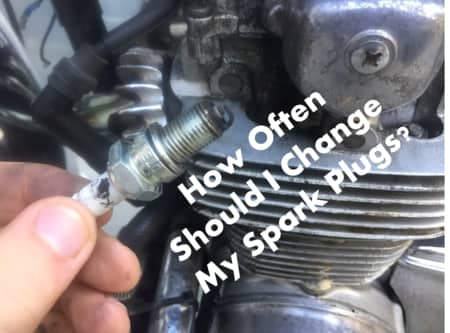Spark plugs are one of those things that you don’t think about every time you ride your motorcycle. They are not part of the normal pre-ride checklist like tires or turn signals. But, they can’t be ignored completely. At some point they are going to need to be replaced.
So, how often should you replace your motorcycle plugs? For most modern motorcycles, spark plugs should be replaced every 15,000 to 16,000 miles. But, if your motorcycle is running rough, sputtering, or is losing power, spark plugs should be inspected and replaced if necessary.
Your first step to answering this questions is to check the maintenance schedule in your owner’s manual for the recommended intervals. If your motorcycle is running properly, or if you’ve purchased it new, you shouldn’t have to replace them any sooner. For most motorcycles, it’s every 16,000 miles.
But, if your motorcycle is having engine problems, such as, running rough, sputtering, or it dies at idle speed, part of your troubleshooting process should include inspection of the spark plugs and replacement if necessary.
If you’ve purchased a used motorcycle, especially one that has been sitting unridden for a while, then you should absolutely inspect the spark plugs. Ask the previous owner when was the last time they were changed. If they don’t recall, then replacing them is the safest option.
How to Inspect Spark Plugs
Spark plugs can tell you quite a bit of information about the condition of the motorcycle. When you inspect them, there are a few things you need to look for.
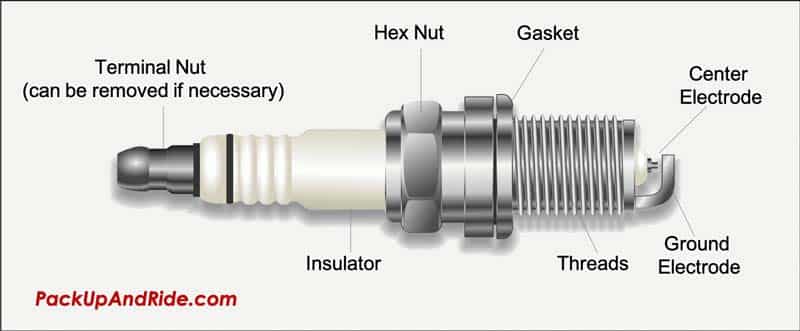
What Does the Color Tell You?
Under normal conditions, the spark plug electrodes will have combustion deposits which are grayish-brown in color. They should be dry and the electrodes should not be misshapen. This color is normal and means your motorcycle is running normally.
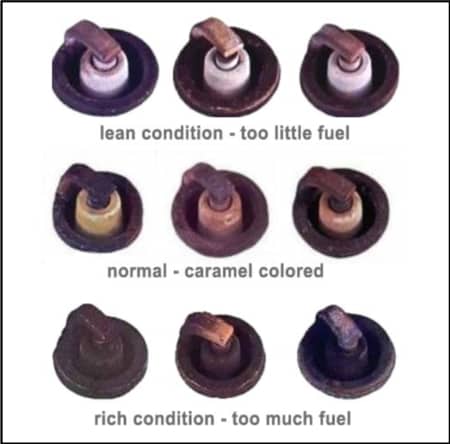
If the plugs are wet, or covered in oil, this means that the motorcycle is having more serious issues that should be looked into. It often means that oil is leaking from the valves or pistons. If this is the case, the problem should not be ignored. Have the motorcycle inspected and repaired by a mechanic.
Very dark coloring at the electrodes means that more carbon is being deposited as the engine fires. This is a sign that the engine is running rich, or too much fuel in the mix. The spark plugs should be replaced and adjustments should be made to the fuel/air mixture.
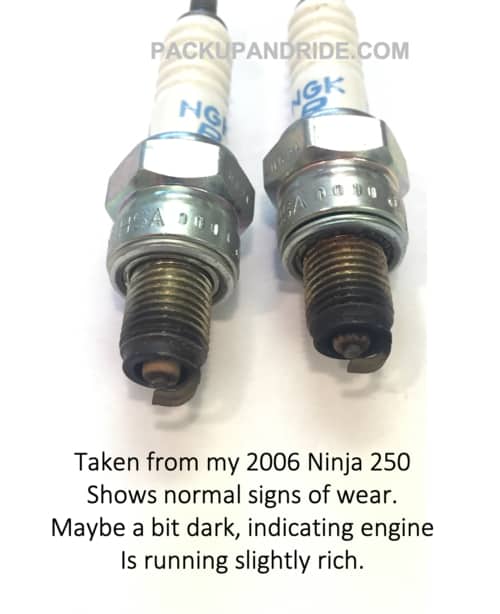
If you’ve been having carburetor issues, such as clogged jets, you will likely need to replace spark plugs after fixing the carburetor problems. Why? If the carbs have been running too rich, it will leave more carbon deposits on the spark plugs. Also, if you’re going so far as to remove the carburetors from your bike, you may as well go the extra step and throw in some new plugs. The cost and time is minimal.
Another sign that your spark plugs should be replaced, is unusual erosion or wear on the terminals, or cracks in the ceramic insulation. If you notice uneven wear on the center electrode, if it’s worn to a point, or if it’s worn more on one side than the other, then it’s time to change the spark plugs.
If the ground electrode is unusually worn or excessively corroded, it should be replaced.
Replacing the spark plugs.
Replacing the spark plugs is one of the more simple motorcycle maintenance jobs you can often do yourself depending on the type of bike you have. If your motorcycle engine allows free access to the spark plugs, it’s as simple as remove and replace.
Some motorcycles require removal of the gas tank to access the spark plugs. While this seems like a tough job, it’s usually pretty basic and can be done fairly quickly. Check your service manual for the procedure for your specific motorcycle.
Spark plug removal requires a special socket called a spark plug socket, of course. These sockets are fairly long and contain a rubber grommet inside that grips the plug’s terminal, making it easy to pull out the plug.
A lot of times a motorcycle’s on-board tool kit, provided by the bike’s manufacturer, will include a spark plug socket. If yours does not, then you can easily find one at any local auto parts store, or motorcycle parts store. Before you go out and buy one, check your owner’s manual to see which size you should purchase.
The steps for replacing your motorcycle’s spark plugs will be very similar to the steps listed below. However, there will be some differences depending on where your plugs are located and how easily they are accessed. A lot of modern motorcycles require removal of the fuel tank. So, before you jump into it, check a service manual for the proper tank removal procedure.
- Remove gas tank if necessary
- Remove the spark plug wires by pulling, firmly, straight up.
- Insert the spark plug wrench into the chamber.
- Using a wrench or socket wrench, unscrew the spark plug
- Pull out the socket and the spark plug should come up with it
After removing the spark plugs, inspect them for any signs of unusual wear or coloring. If the color and wear is normal, no further investigation is necessary and you can install the new plugs. However, if you see something out of the ordinary, then you should consider taking steps to fixing any issues your motorcycle may have.
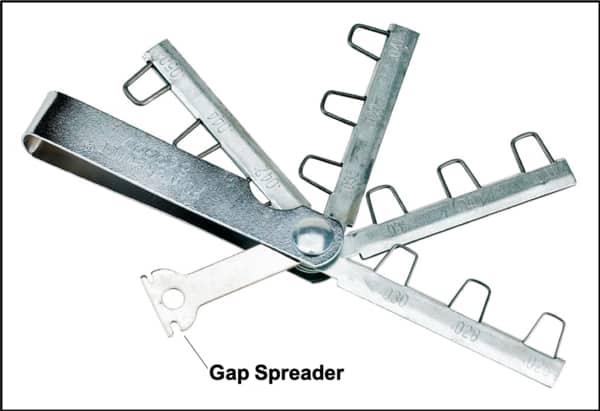
Before installing the new spark plugs, check and adjust the terminal gap. While most of the time a plug will come properly gapped, you should still double check. Look up the recommended gap in your owner’s manual, then measure the gap with a gap tool.
If you need to adjust the gap, do not use a screwdriver wedged in there. Doing this can damage the electrodes. A good gap gauge will come with a gap spreader tool.
To install the new plugs reverse the procedure listed above. Tighten the plugs firmly, but do not over tighten them. You may have to wiggle the socket a little to pull it out.
Before reattaching the spark plug wires, inspect them for any cracks, which can lead to a loss of power. If it’s all ok, then reattach the wires. Make sure you push them down firmly to make sure they are completely seated onto the spark plug terminal.
What Kind of Spark Plug is Best?
Today’s spark plugs have improved a great deal and last much longer than spark plugs that were made 20 or 30 years ago. Also, the material used to make them have improved. The electrode core can be made from copper, platinum or iridium.
Copper is generally the most common and less expensive type, and will be a perfectly good choice for your motorcycle if you ride under normal conditions.
Platinum spark plugs will last longer than copper and can handle higher heat without breaking down. If you ride hard, and your bike runs at higher RPMs, these might be a good choice.
Iridium spark plugs are known for lasting the longest and performing well under harsh conditions, such as racing.
All brands that manufacture spark plugs will offer a range of quality and performance ratings. If you stick with a name brand such as NGK, ACCEL, Autolite or Champion, you’ll be getting a quality spark plug. But, some riders have a brand preference.
Spark plug life on a motorcycle is not the same as spark plug life on an automobile. Although cars can go 100,000 miles without a spark plug change, it’s not so with motorcycles. So, now you know, change your spark plugs every 16,000 miles, give or take, or change them if you have engine problems, especially those related to fuel or carburetor issues.

